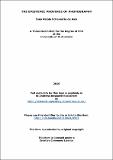Files in this item
The epistemic province of photography
Item metadata
| dc.contributor.advisor | Gaut, Berys Nigel | |
| dc.contributor.advisor | Prosser, Simon | |
| dc.contributor.author | De Asis, Ines Nicole Echevarria | |
| dc.coverage.spatial | 194 p. | en_US |
| dc.date.accessioned | 2016-06-10T15:43:40Z | |
| dc.date.available | 2016-06-10T15:43:40Z | |
| dc.date.issued | 2016-06-23 | |
| dc.identifier | uk.bl.ethos.687034 | |
| dc.identifier.uri | https://hdl.handle.net/10023/8963 | |
| dc.description.abstract | This thesis argues that photographs enhance the repertoire of seeing the way eyeglasses, microscopes and telescopes do. This kinship is based on these devices sharing a feature called transparency. Transparent devices facilitate visual information about objects without interrupting the causal link between the object and our eyes, and do so by maintaining a belief independent and similarity preserving counterfactual dependence on that object. Handmade pictures also offer visual information about objects, but because handmade pictures depend on the perceptual experiences of their makers, they interrupt the causal link between the object represented and our eyes. Consider how a drawing can represent the misperceptions and hallucinations of its illustrator, but in contrast, photographs do not reproduce the contents of hallucinations or misperceptions had by their photographers. I use transparency to map the epistemic province of photographs, arguing that photographs are not just ontologically similar to microscopes and telescopes, but also epistemically akin to them, –perhaps even more than they are like other picture types. This is illustrated by two further comparisons. The first is technological: while cameras define the information scope of photographs, handmade pictures are not subject to pre-sets that strictly limit their representational scope in the same way. The second comparison shows how photographs and handmade pictures are subject to different sceptical hypotheses: handmade pictures are susceptible to scepticism about their illustrator, –i.e., as we might question the credibility of someone giving testimony– but photographs are not beholden to scepticism about their photographer. I conclude with a proposal on the epistemology of photography, where contrary to the character of other picture types, photographs provide genuine perceptual knowledge about objects. | en_US |
| dc.language.iso | en | en_US |
| dc.publisher | University of St Andrews | |
| dc.relation | Kendall Walton, Transparent Photographs: On the Nature of Photographic Realism. | en_US |
| dc.rights | Attribution-NonCommercial-NoDerivatives 4.0 International | * |
| dc.rights.uri | http://creativecommons.org/licenses/by-nc-nd/4.0/ | * |
| dc.subject | Transparency | en_US |
| dc.subject | Photographs | en_US |
| dc.subject | Epistemology of photography | en_US |
| dc.subject | Kendall Walton | en_US |
| dc.subject | Perception | en_US |
| dc.subject.lcc | TR183.D42 | |
| dc.subject.lcsh | Photography--Philosophy | en_US |
| dc.subject.lcsh | Perception (Philosophy) | en_US |
| dc.subject.lcsh | Walton, Kendall L., 1939- | en_US |
| dc.title | The epistemic province of photography | en_US |
| dc.type | Thesis | en_US |
| dc.type.qualificationlevel | Doctoral | en_US |
| dc.type.qualificationname | PhD Doctor of Philosophy | en_US |
| dc.publisher.institution | The University of St Andrews | en_US |
The following licence files are associated with this item:
This item appears in the following Collection(s)
Except where otherwise noted within the work, this item's licence for re-use is described as Attribution-NonCommercial-NoDerivatives 4.0 International
Items in the St Andrews Research Repository are protected by copyright, with all rights reserved, unless otherwise indicated.


